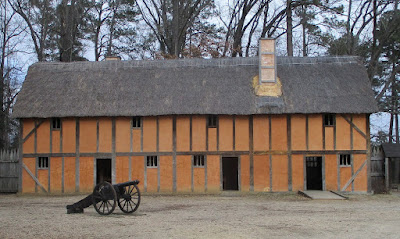Today I visited Jamestown Settlement, a museum dedicated to the early history of Virginia. It is totally separate from the Jamestown colony, which I visited in July 2021. The museum includes both indoor and outdoor exhibits, the latter of which I decided to photograph. On the way to these, I passed a brick tower, on which this historical plaque is mounted.
The museum includes a recreation of Fort James, which was active from 1610 to 1614. The closest building in this photo is its church.
This building might have been the fort's armory, since I saw weapons and military armor in and around it. Note the three suits of armor, including helmets, mounted on a wooden frame in the middle of the picture.
This white building is the fort's storehouse.
The building shown in the next shot is the largest in the fort, and was thus probably a barracks or living quarters.
The museum grounds extended to the James River, and includes the docks at which three ships are moored. To the right is part of the Godspeed. To the left and flying the Union Jack is the Discovery, behind which is the Susan Constant. These ships are replicas of the three ships that carried English colonists to what is now Virginia in 1607.
I took a closer shot of the Discovery. She and the Godspeed were closed to visitors.
The Susan Constant was the largest of the ships, and includes a balcony around her stern. Visitors were able to walk through and on top of her fore and aft cabins, as well through the first deck below her main deck. The rigging seen to the right is part of the Discovery.
The outdoor exhibits include a recreation of a Paspahegh village. This tribe was a tributary to the chiefdom led by paramount Chief Powhatan and was largely wiped out in a massacre by 70 Jamestown colonists. The recreated village includes this hut and a frame for drying animal skins.
Here are two more huts.
The village includes this elevated structure, which might have been used to store foodstuffs such as corn.
Lastly, the village includes this circle of poles, each with an inward-looking face.
To learn more about the museum, besides the above link, go to TripCanvas.












No comments:
Post a Comment